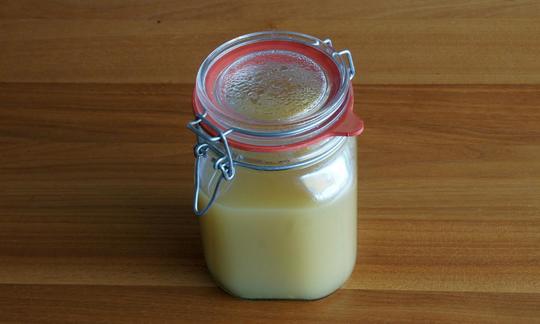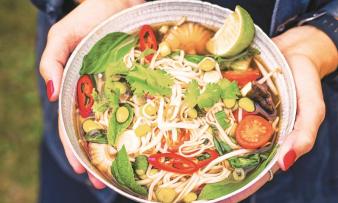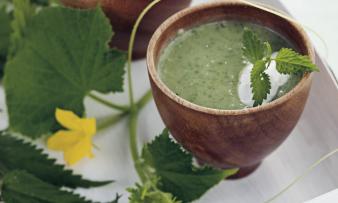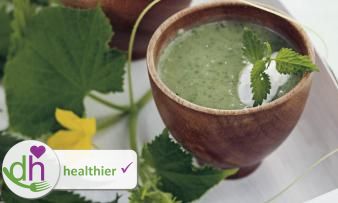Table of contents
Vegan vegetable stock ( organic ) has a strong taste and is used as a basic ingredient for soups and sauces.
Use in the kitchen
Vegetable stock is not eaten on its own as it has a very intense flavour. It is used in a similar way to vegetable broth to flavour sauces, braised dishes, risotto , dals , stews and soups . Food cooked in stock has more flavour as it contains flavours and minerals, some of which are transferred to the food being cooked.
High-quality stock does not contain salt . The salt it contains comes naturally from the ingredients used. The advantage is that vegetable stock without added salt allows you to determine the salt content yourself by adding more. Once your taste buds have adjusted (takes around 3 months), you no longer need to add any salt.
How do bouillon, broth and stock differ? With vegetable stock, you boil the vegetables in water. You don't eat the vegetables, but you separate them from the stock after boiling. That's why "vegetable waste" such as trimmings and peels, and possibly herbs and spices, are suitable for making stock. In contrast to stock, with vegetable broth, you only boil the vegetables in water until they are cooked. At the end, you can add salt to the broth, but you don't have to. You can eat the vegetables with the broth, or you can filter the vegetable broth to use it later. Bouillon is a strong broth (concentrated broth) that thickens through prolonged cooking and water evaporation. It is important that you boil the vegetables in cold water without salt. This is the only way the aroma can pass into the water. In addition, the water should not bubble, but only simmer gently to preserve the aroma.
Making your own vegetable stock
Vegetable stock without salt is easy to make yourself, from different types of vegetables. Root vegetables such as carrots , celeriac , leeks , savoy cabbage and onions are suitable. You can supplement these with parsley , lovage , thyme , cloves or bay leaves . Button mushrooms , porcini mushrooms and shiitake mushrooms give the stock a hearty taste. Beetroot , pak choi , broccoli , white cabbage and kohlrabi are less suitable because they make the stock bitter. Using corn , potatoes , pumpkin and sweet potatoes leads to the stock becoming cloudy. A small chili pepper provides spiciness if required.
The following link takes you to our recipe: vegan vegetable stock .
Vegan recipe for pumpkin soup with vegetable stock
Ingredients (for 4 people): 1 Hokkaido pumpkin (raw), 2 carrots (organic), 1 sweet potato (raw), 2 shallots (raw), 1 teaspoon rapeseed oil , 1 l vegetable stock, 1-2 cm ginger (raw), 1 teaspoon chili flakes , 1 teaspoon sweet paprika powder , salt ,black pepper , 8 stalks parsley (raw).
Preparation: Wash and dry the pumpkin, then cut in half with a knife. Scrape out the seeds with a spoon. Cut the flesh into small pieces. Peel the sweet potato and wash the carrots, then cut into small pieces. Peel the shallots and chop finely. Wash the parsley, shake dry, then chop.
Heat rapeseed oil in a pan and sauté shallot, pumpkin and carrots. Then add sweet potato and Add the chili flakes and fry while stirring. Deglaze the vegetables with the stock and stir everything well. Add the stock little by little. Mix in the paprika powder, a pinch of salt and pepper and let the vegetables simmer for about 15 minutes. Peel the ginger and grate finely. Add the ginger to the soup and stir well. Take the pot off the stove and use a hand blender to finely purée the soup. Pour the pumpkin soup into bowls or soup plates and sprinkle with the freshly chopped parsley.
Vegan recipes with vegan vegetable stock can be found under the note: " Recipes that use the most of this ingredient ".
| Not only vegans or vegetarians should read this: Vegans often eat unhealthily. Avoidable nutritional errors . |
Purchasing - Storage
Vegetable stock can be bought in liquid form, usually packaged in screw-top jars. Major retailers such as Migros , Spar , Rewe , Edeka , Hofer and Billa have vegetable stock in their range, some of it organic. Aldi and Lidl sometimes have it on special offer. Coop , Denner and Volg do not have vegetable stock as standard. You can also sometimes buy vegetable stock in health food stores and organic supermarkets such as Denn's Biomarkt and Alnatura . The vegan vegetable stocks you buy often contain added salt, vegetable oil, yeast extracts, flavors and stabilizers. If you want to use "salt-free" vegetable stock without additives, you often have to make it yourself.
The availability of vegetable stock varies depending on the size of the store, catchment area, etc. Our recorded food prices for the DA-CH countries can be found above under the ingredient image - and by clicking you can see their development at various suppliers.
Storage tips
Purchased vegetable stock can be stored dry and protected from light at room temperature until the best-before date. Opened jars should be kept in the refrigerator and consumed within a few days.
Homemade liquid vegetable stock can be stored in jars in the refrigerator for a few days. For a longer shelf life, it should be pasteurized or sterilized.
Ingredients - Nutritional values - Calories
Since the ingredients of a vegetable stock vary, no general statement can be made regarding ingredients and nutritional values. The values given in the nutrient tables are calculated from the ingredients in the vegan vegetable stock recipe. These are approximate values, as this is a natural product.
100 g of vegan vegetable stock provides an energy content of 16 kcal. It is practically fat-free (0.57 g/100g) and protein-free (0.37 g/100g). It contains only a few carbohydrates (2.6 g/100g). With a salt content of 50 mg, it contains very little salt. 1
You can find all the ingredients of vegan vegetable stock, the coverage of the daily requirement and comparison values with other ingredients in our nutrient tables. In the article Nutrients explained you will get a detailed insight into the topic.
Effects on health
Homemade vegetable stock made from 100% vegetables and herbs, scores points for its naturalness. In addition to a very low sugar and sodium content that occurs naturally in vegetables, it contains no added flavors, flavor enhancers (glutamate, yeast extract), preservatives, fillers or added salt and sugar.
Vegan vegetable stock without added salt helps reduce sodium consumption. Excessive salt consumption is associated with an increased risk of hypertension (high blood pressure), cardiovascular disease and organ-damaging secondary diseases. 6,7 For this reason, the WHO recommends keeping sodium intake below 2 g per day, which corresponds to less than 5 g of salt per day (≈ ¾ tsp). 8
Dangers - Intolerances - Side effects
Celery is contained in many vegetable stocks and is one of the 14 main allergens. If you are sensitive to celery, read the ingredients list of a purchased vegetable stock carefully.
Vegetable stocks can contain yeast extract as a flavor enhancer. Yeast extract is an industrially modified ingredient and unhealthy in large quantities. For a long time it was considered the better alternative to artificially produced glutamate. Yeast extract is now also controversial because of the glutamic acid it contains. This has a similar effect to glutamate and blocks the feeling of satiety, so that we eat more than necessary. 2,3 Organic yeast extract is no better and we recommend using natural herbs and spices to improve and intensify the flavor. Yeast extract is not a food additive and does not have to be officially labeled as a flavor enhancer, unlike industrially produced monosodium glutamate (MSG) E 621 or other glutamates in isolated form. 4 Even products with the EU organic seal 5 may contain yeast extract - but glutamate is prohibited there.
Ecological footprint - animal welfare
Commercial vegetable broths have a CO 2 footprint of approximately 1.13 - 5.03 kg CO₂e/kg. 9 This greenhouse potential can be roughly compared with organic tomatoes (1.1 kg CO2eq/kg) and whole milk (1.4) to fish from aquaculture (5.1). 16
The Tagesspiegel in cooperation with AYCE.earth offers the possibility to calculate the CO 2 footprint of your own recipes on its website (see sources). 11 We tried this out with our recipe for vegan vegetable stock :
A standard portion of our homemade broth, i.e. 33% of the daily nutrient requirement, produces 319 g of CO 2 . If you convert the greenhouse gas potential to the calorie content, you get 621 g of CO 2 per 500 kcal. This means that the vegetable broth produces 38% fewer CO 2 equivalents than the average of the foods examined. The soup can therefore be classified as very climate-friendly. 11
While vegetable and chicken broth are in the "green" range, beef broth falls into the category 'These foods worsen our carbon footprint'. 12
We could not find any specific data on the water footprint ; only one study on the water footprint of gazpacho: This cold Spanish soup consists of tomatoes ,pepper , onion , cucumber , garlic , olive oil and vinegar . The water footprint according to this calculation was 580.5 l/l of soup. 10 For comparison: The global average water footprint of vegetables is 322 l/kg, fruit is 962 l/kg, eggs 3265 l/kg and beef 15,415 l/kg. 13
Detailed explanations of various sustainability indicators (such as ecological footprint, CO2 footprint, water footprint) can be found here .
Animal welfare - species protection
When buying, look for organic certificates. Chemical substances used in conventional agriculture not only have negative effects on our health, 15 but also on all other living creatures. In the EU, 24.5% of endangered species are threatened by agricultural pollutants such as pesticides and synthetic fertilizers. 14
Worldwide occurrence - cultivation
Vegetable stock and vegetable broth are used worldwide. Depending on the region and season, they are made from different combinations of ingredients. Root vegetables such as carrots , kohlrabi , celeriac and onions are often used. For an Asian-inspired vegetable stock, you can also use ginger , lemongrass or Thai basil (Horapa) .
Further information
Commercially available vegetable stock consists mainly of salt, fat, seasoning, flavour enhancers, spices and only a small amount of vegetables. Salt makes the vegetable stock last longer. The content varies greatly depending on the manufacturer.
Alternative names
In English, vegetable stock is called vegetable broth. Vegetable broth is the name for vegetable stock .











Comments